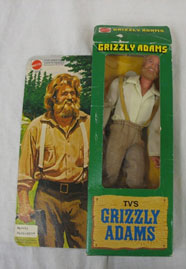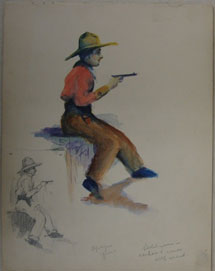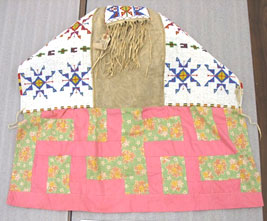The Museum registration department is responsible for new acquisitions to the state’s museum collection, incoming and outgoing artifact loans, creating and upholding museum collections policies and procedures, and keeping track of the collections with regular inventories and database updates.
Does the Museum Division accept donations for the collection from the public? We receive about two hundred offers of various objects to the state’s museum collection every year. These collections may be one object or a hundred objects, and the items range from tractors to paintings to taxidermy. The Museum Collections Committee (MCC) meets twice a month and consists of staff from various fields including the museum collections care, exhibits, education, and historic sites, along with input from geologists, archaeologists, and others when deemed necessary. The MCC proposes to the Museum director what we should or should not accept for the state’s museum collection, with the Museum director making the final decision.
How does the MCC decide what to accept and what to decline? We ask potential donors to fill out a Potential Acquisition Questionnaire, found on our website at http://history.nd.gov/donate.html. We want a detailed description of the objects, what is known about them, and how the items are related to North Dakota. The stories that come with the objects are just as important as the objects themselves. We ask our donors to provide as much information as possible about their donations and, if they exist, provide related photographs and documents in order to provide context. The objects being offered are then compared to the current museum collections. If we do not already have similar objects with similar stories, and we are sure we can properly care for the objects, we most likely will accept the offer.
If a donation is accepted for the museum collection, the donor signs a gift agreement that transfers legal ownership of the objects to the State Historical Society of North Dakota. Once we have a signed gift agreement, we arrange for transportation of the donation. We prefer not to have possession of any objects before the state actually owns them.
Although we cannot guarantee donated objects will go on exhibit, we do guarantee that your donation will be cared for to the best of our abilities. In addition, all objects are available to researchers and sometimes to other museums as a temporary loan. When museum studies interns are available, one of their projects is to create an exhibit case in the State Museum called “Recent Acquisitions” that showcases a few acquisitions from the previous year. The case currently on display includes a mailbox, a 1970s Milton Bradley board game called Sub Search, a cell phone, and a Boy Scout uniform. In the future, we will use this blog as a way to show additional recent acquisitions to the collection.
Below are three examples of recent acquisitions:

Grizzly Adams doll from the collection of the Ruth M. Haugen Ekland Estate. 2013.102.26
The doll, or some may call it an action figure, was part of a large donation offer of household items, children’s toys, and farm equipment from northeastern North Dakota. Grizzly Adams is a popular generational figure remembered by many from their childhoods.

Clell Gannon artwork donated by Carolyn Twingley. 2013.111.205
Clell Gannon was a North Dakota artist. He not only created murals for the exhibits at the Liberty Memorial, the State Historical Society’s previous home, but also designed the Oscar H. Will & Co. seed catalog covers for many years.

Soft cradle donated by Elizabeth Cantarine. 2013.122.1
The soft cradle was made by the daughter of Andrew Ireland (Mary Comes Last) from Cannonball, ND. It won first prize for beadwork at the Fort Yates Fair in 1932.
Any request to use the images should be requested by completing a “REQUEST FOR ONE-TIME USE OF PHOTOGRAPHIC IMAGE” that can be found at: http://history.nd.gov/pdf/request_for_one_time_use.pdf

